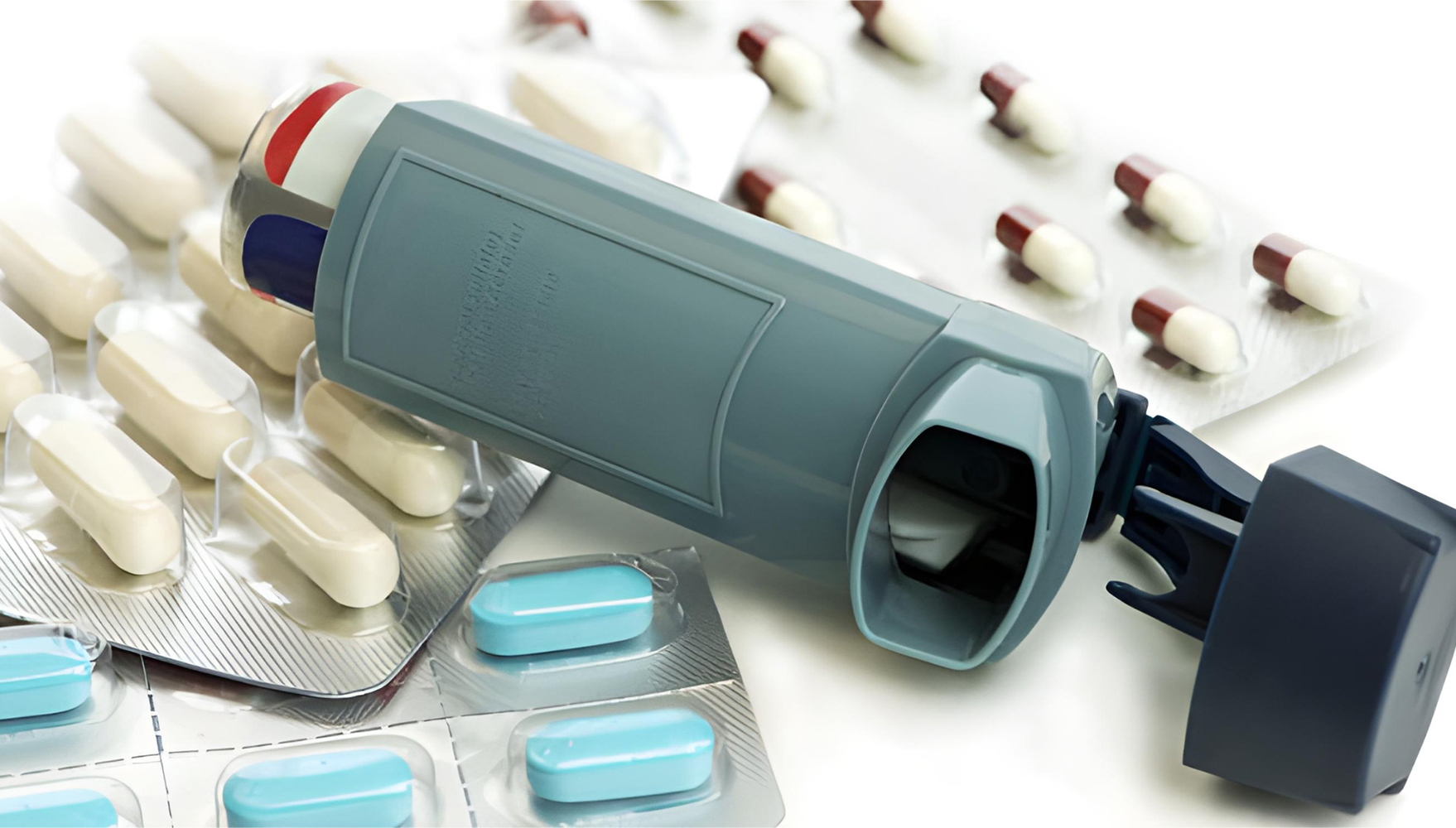What Causes Asthma?
Asthma involves a complex interaction between many cells and inflammatory mediators, such as:
- Eosinophils
- Mast cells
- Macrophages
- Interleukins
- Leukotrienes.
Most asthma medications work by reducing the inflammation and opening up the airways my muscle relaxation.
Let’s know about some of the asthma treatment drugs.

Anti-Asthmatic Drugs- Classification and Uses
Anti-asthmatic drugs are designed to manage and relieve the symptoms of asthma. These medications can be broadly classified into 5 main categories.
1. Bronchodilators
(a) Sympathomimetics
(i) Selective B2-adrenergic agonists:
- Short-Acting Drugs:
- Have a rapid onset (1-5 minutes) and short duration of action.
- Administered via inhalation.
- Provide quick relief from acute asthma attacks
Examples: Salbutamol and terbutaline
Dose (for salbutamol): 100- 200 mcg
Time: Every 6 hours
Method of administration: Metered Dose Inhaler (MDI).
- Long-Acting Drugs:
- Have an extended duration of action.
- Employed as a maintenance dose.
- Not suitable for acute attacks due to their slower onset.
Examples:
Salmeterol: Used for maintenance therapy
Dose: 50 mcg
Time: Twice daily
Method of administration: Inhalation
Formoterol: Used for the chronic management of asthma symptoms
Dose: 12-24 mcg
Time: Twice daily
Method of administration: Inhalation
(ii) Nonselective:
These are nonselective sympathomimetics.
Mode of Action:
- Induce rapid and potent bronchodilation by stimulating β2-adrenergic receptors
Example: Adrenaline
Dose: 0.2–0.5 mL of a 1:1000 solution
Mode of Administration: Subcutaneously
Drawback: Severe cardiac side effects
Non-selective asthmatic drugs are generally not recommended for patients nowadays.
(b) Methylxanthines
Mode of Action:
- Relaxation of the smooth muscles of the airways
- Also have anti-inflammatory properties
Examples: Aminophylline, Etophylline, Theophylline
Drawback: Narrow therapeutic window
Severe side effects
(c) Anticholinergics
Mode of Action:
- Blocks the action of Acetylcholine
- Prevents binding of ACh to receptors
- Promotes bronchodilation
These are used for patients who do not respond well to β2-adrenergic agonists.
Examples: Tiotropium bromide, Ipratropium bromide
2. Leukotriene Receptor Antagonists
Mode of Action:
- Blocks the effects of leukotrienes
- Prevents release of inflammatory mediators
- Prevents bronchoconstriction
- Relives inflammation
- Lowers mucus production
They are used for chronic asthma management.
Example: Zafirlukast, Montelukast
3. Mast Cell Stabilizers
Mode of Action:
- Prevents the release of inflammatory mediators from mast cells
- Reduces inflammation
- Lowers hyperresponsiveness
They are used for prophylactic treatment.
Examples: Sodium cromoglycate, Nedocromil sodium, Ketotifen
4. Glucocorticoids
These are divided into two categories:
(a) Inhaled glucocorticoids
Mode of Action:
- Reduce inflammation
- Prevent exacerbations
Example: Beclomethasone, Budesonide, Fluticasone
Sample Questions for the OPRA exam:
|
(b) Systemic glucocorticoids
- Used for severely aggravated asthma
- Employed for short-term use
These have severe side effects.
Examples: Hydrocortisone, Prednisolone, Methylprednisolone
Sample Questions for the OPRA exam:
|
5. Anti-IgE Monoclonal Antibody
Mode of Action:
- Targets IgE, which is involved in allergic responses.
It is used for moderate to severe allergic asthma not controlled by common therapies.
Example: Omalizumab
Common Side Effects and Precautions
The common side effects and precautions of the anti-asthmatic drugs are:
| Anti-Asthmatic Drugs | Common side effects | Precautions |
| Beta2 agonists | 1. Fine tremor (particularly in the hands) 2. Nervous tension 3. Headache 4. Muscle cramps 5. Palpitation | Should be used with caution in patients with 1. Hyperthyroidism 2. Cardiovascular disease 3. Arrhythmias 4. Susceptibility to QT-interval prolongation 5. Hypertension 6. Diabetic patients - monitoring blood glucose may be required due to the risk of ketoacidosis, especially when beta2 agonist is given intravenously. |
| Systemic corticosteroids | 1. Fragile bones 2. High blood pressure 3. Diabetes 4. Weight gain 5. Cataracts and glaucoma 6. Thinning of the skin 7. Easy bruising 8. Muscle weakness | 1. Initial growth velocity may be reduced in children. 2. A potential for paradoxical bronchospasm. |
| Inhaled corticosteroids | 1. Fungal infection of the mouth or throat, 2. May develop a hoarse voice | 1. Monitor the height and weight of children annually 2. Association with adrenal crisis and coma in children, thus avoid excessive dose |
| Leukotriene inhibitors | 1. Abdominal pain 2. Thirst 3. Headache 4. Hyperkinesia (in young children) | 1. Should not be used for the treatment of acute asthma attacks 2. Caution in pregnancy and breastfeeding |
| Xanthine | 1. Nausea 2. Vomiting 3. Gastric irritation 4. Diarrhea 5. Palpitation 6. Tachycardia 7. Arrhythmias 8. Headache 9. Insomnia | Should be used with caution in patients with 1. Heart failure 2. Hepatic impairment 3. Viral infections 4. Elderly 5. Smokers 6. Alcoholics Should avoid the concurrent use of intravenous and other routes of administration of xanthine |

To Sum Up
The management of asthma and asthmatic drugs is an important topic for all OPRA exam aspirants. The drugs range from bronchodilators to anti-inflammatory drugs. The medications given to the patient depend on the severity of the attack. Patient medical history also influences drug selection.
Also Read: OPRA Exam Books
This comprehensive guide to anti-asthmatic drugs is for all medical and pharmacological students. With multiple classes and modes of action, a well-classified list makes learning easier.
If you need an elaborate explanation or have questions regarding this topic, join Academically’s OPRA Exam Preparation Course. You will get access to detailed explanations on each topic, practice questions, and personalised guidance.
You can also get in touch with our experienced teachers to clear any doubts regarding the OPRA exam or its preparation strategy.





